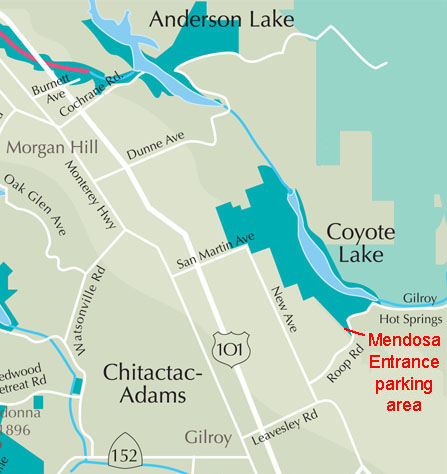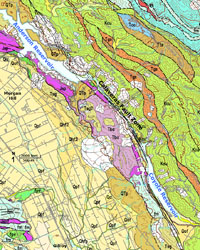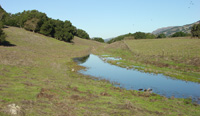
Field Trip to the Calaveras Fault in Coyote-Harvey Bear County Park
|
|
Field-trip overview: This field trip is to examine the landscape and geology along the Calaveras Fault in the vicinity of Coyote-Harvey Bear County Park in the foothills of the western Diablo Range near Gilroy, California. This trip involves about a 2.5 mile starting at the Mendoza Entrance parking area. The hike is a moderately easy loop walk along the valley along the Calaveras Fault and around the hilltop—the southern end of Coyote Ridge. The hike provides opportunity to examine volcanic rocks formed about 2-3 million years ago that erupted and flowed along the ancestral valley of the Calaveras fault.
Directions: To get to Stop 1, take the Leavesley Exit off of highway 101 east 2 miles, turn left (north) on New Avenue.
Proceed 0.5 mile and turn right (east) on Roop Road.
Follow Roop Road 3 miles into the foothills and turn left into the Mendoza Entrance Parking area. Parking at this site is free. |
 |
 |
|
| Map showing the location of the Mendoza Entrance parking area near Gilroy |
 |
Geologic map of the Calaveras Fault in the Diablo Range and Santa Clara Valley in the vicinity of Morgan Hill and Gilroy, California (U.S. Geological Survey2) |
| Map showing the route of the Coyote Ridge and Mendoza loop trail route |
Click on small images for a larger view. |
Santa Clara County Parks information
http://www.parkhere.org/portal/site/parks
Park Trails Hotline: (408) 355-2200, press 7, then press 2 for trail closure information.
For general open/close information, please call (408) 225-2147. |
1Forrest McFarland, pers. comm, 2010, member of a USGS/SFSU regional fault creep measurement team.
2Wentworth, C.M., Blake, M.C., Jr., McLaughlin, R.J., and Graymer, R.W., 1998, Preliminary Geologic Map of the San Jose 30 X 60 Minute Quadrangle, California: A Digital Database: U.S. Geological Survey Open-File Report 98-795, map and technical report are available online at: http://pubs.usgs.gov/of/1998/of98-795/
Bryant, W.A., and Cluett, S.E., compilers, 1999, Fault number 54c, Calaveras fault zone,Calaveras section, in Quaternary fault and fold database of the United States: U.S. Geological Survey website, http://earthquakes.usgs.gov/regional/qfaults, accessed 09/07/2012 12:51 PM.
|
|






